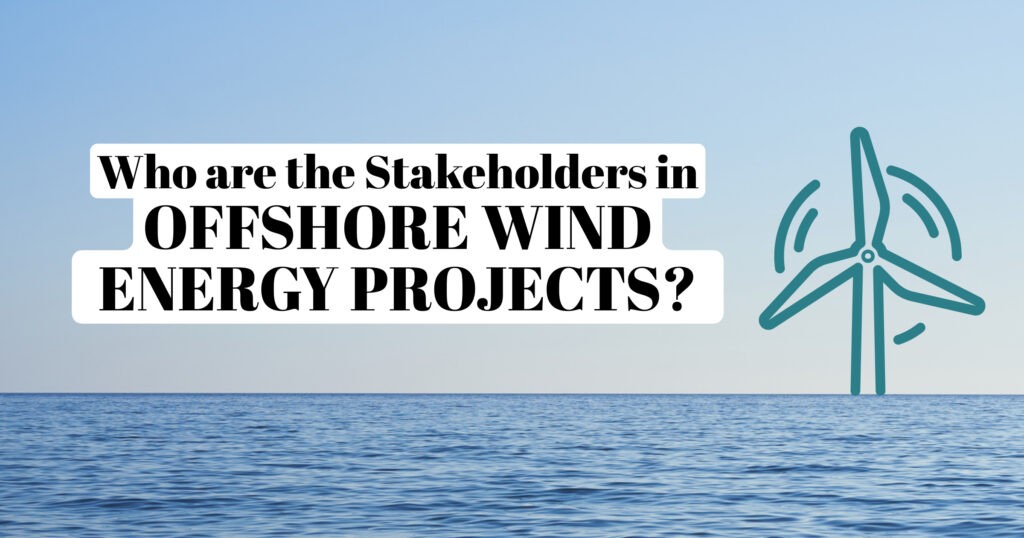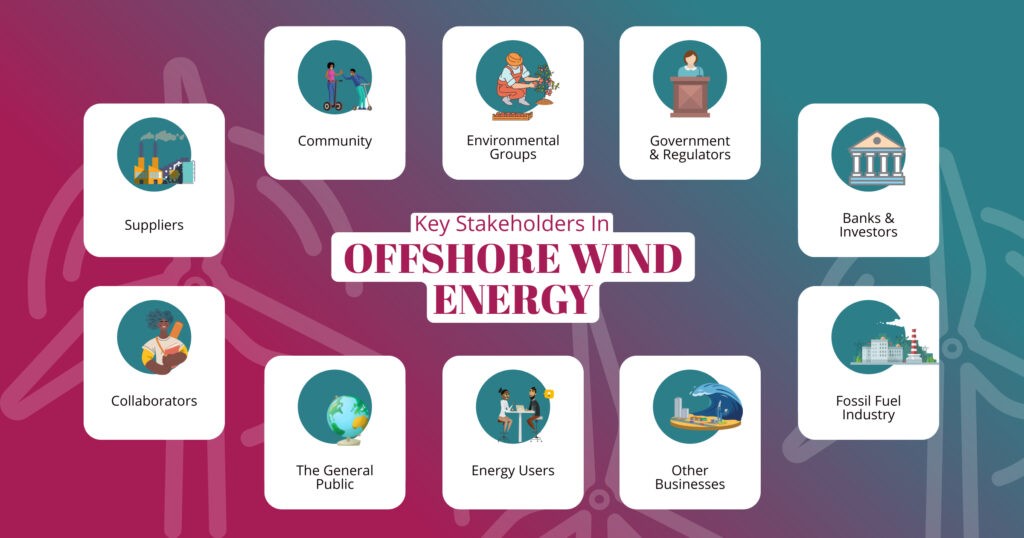Who are the Stakeholders in Offshore Wind Energy Projects?

Offshore wind energy is continuing to gain momentum around the world.
An estimated 261 offshore wind farms are operating around the world as of January 2023, with further estimates suggesting that the number of individual turbines will increase from around 2,500 in 2020 to 30,000 by 2030.
It’s critical that the organizations behind this rapidly growing industry prioritize stakeholder engagement to ensure that each project delivers maximum benefits as a renewable energy source, while minimizing potential negative impacts on stakeholders. Here, we’ll share more about why stakeholders matter for offshore wind projects — and who those stakeholders might be.
The Importance of Stakeholders in Offshore Wind Projects
Offshore energy is pretty straightforward — a fantastic option that’s more sustainable for the planet than the alternatives. Who wouldn’t want it? In fact… why don’t we just put turbines everywhere we possibly can?
Well, when you put it that way, you start to see that it’s not quite so straightforward. And what might at first seem like a more sustainable option might not tick all the boxes for sustainability (environmental, social, economic). The importance of stakeholders and stakeholder engagement becomes increasingly obvious.
Fortunately, when you start to engage with those stakeholders (especially during the initial planning process), you can start to unpack the various issues and complexities behind offshore wind — and how you can best navigate them for a good outcome.
For instance, stakeholder engagement can help you better manage risk and increase social acceptance. And by engaging with groups that are impacted by or have an influence on the project, you can discover insights that help you make the project more sustainable and valuable.
Finally, it’s worth mentioning that most offshore wind projects will require stakeholder engagement and public consultation to satisfy local laws.
One example that illustrates this is the Australian Department of Climate Change, Energy, the Environment and Water’s Offshore Electricity Infrastructure 2021 Act (OEI). This act outlines how and where offshore electricity infrastructure can operate. Regulations are currently being developed that will cover planning, a design notification scheme, WH&S, and more. DCCEEW also mentions that in order to grant a license for offshore infrastructure, the project should be in the national interest, which includes considering the project’s impact on the economy and local communities — and any mitigation of conflicts with other users of the area.
10 Key Wind Energy Stakeholders

So, who are the stakeholders in wind energy? Nearly every offshore wind project will have the same set of stakeholder groups — each with different levels of impact, influence, and interest in/on the project. Here are the key groups to be aware of so you can get a headstart on creating your stakeholder list:
Suppliers & Subcontractors
The businesses and engineers that manufacture, transport, and install the wind turbines are certainly key stakeholders in offshore wind energy projects. These stakeholders have a significant influence on the outcomes of the project — any delays or quality issues could cause major disruption to the farm, as well as negative impacts on the environment.
It’s also a good idea to consider stakeholders further up the supply chain. For instance, offshore wind farms should ensure that their sources of steel (recycled or newly mined iron) are reliable and ethically sourced to further minimize negative impacts.
Likewise, any subcontractors that are involved in operating or maintaining the offshore wind farm are key stakeholders that will need careful management and engagement. It could also be important to consider the relationship between different operators or subcontractors that need to cooperate on the project — as these stakeholders may see each other as competitors.
Learn more about supplier relationship management.
Collaborators
Consider any stakeholders you might collaborate with during the planning stages of the project, and then on an ongoing basis. A good example of a collaborator might be a local university whose students and academic professionals are interested in learning more about offshore wind and perhaps conducting some research.
Community
You’ll almost certainly need to engage with the local community and community groups as part of your offshore wind energy project. Consider who in the community is likely to be more impacted by or have a greater influence on the project, and prioritize these people and groups first.
For instance, people who are located closer to the project and any impacted transport corridors might be more impacted than others and require more careful management and regular engagement.
In the broader community, offshore wind energy could impact people via local job opportunities. The UK government anticipates this sector will support up to 60,000 jobs (directly and indirectly) by 2030. Engaging with your local community can help to fill these jobs as needed.
Another consideration is that it may be important to consult with local indigenous people in the community to determine sites of cultural significance and ensure local customers are respected.
Environmental Groups
Many environmental groups are supportive of offshore wind energy farms as a renewable source of energy. However, some groups will likely hold concerns about their impact on the ocean environment and ecosystems, including birds, fish, and coral. Plus, the environmental impact of the turbines, mining, production, and end-of-life.
Engaging with these groups can lead to valuable knowledge and creative solutions to minimize negative environmental impacts, and increase support for the project.
Government & Regulators
Governments are a key stakeholder in offshore wind energy farms. Not only due to their regulatory role, ability to grant leases, and approval processes but also because many have an interest in taking action towards renewable energy and meeting legislated targets. Local, state, and federal governments will need to coordinate knowledge, skills, and resources to ensure this new industry can succeed. Demonstrating how the project aligns with environmental and sustainability targets as well as legislated requirements will help to ensure productive conversations with this stakeholder group.
Banks & Investors
Financial stakeholders are another group to consider — they’ll want to know that the wind farm is a solid investment, as well as an ethical one. Regular and transparent communication will increase confidence and trust, especially if you can include plans, reports, and data that point to financial outcomes.
Fossil Fuel Industry
The rise in alternative energy sources like offshore wind farms will continue to impact any remaining businesses and employees in the fossil fuel industry. Simply switching off thousands of jobs might not be economically sustainable for communities — even if the energy source is more environmentally sustainable. According to PWC, workforces from decommissioned coal plants will have skills and capabilities that transfer to offshore wind. It’s worth considering how new wind farms could support these workers through retraining and hiring initiatives — and how engaging with these stakeholders early in the process could help facilitate a smoother transition.
Other Businesses & Existing Users
Although they might not be considered key stakeholders in your offshore wind energy project, it’s a good idea to consider other businesses in the region and how they might be impacted or have an impact on the farm. For example, businesses that might share the same ports, local tourism groups, and commercial fisheries that operate in the vicinity. Common causes of conflict for these groups are an inadequate consultation process, the right to compensation if livelihoods are lost, and the lack of adequate data. Engaging with these stakeholders can help you address concerns, facilitate cooperation, and maximize potential usage of the area.
Energy Users
Consider who is going to use the energy generated by your wind farm and what their concerns might be. For instance, they might be concerned about the reliability of the energy produced by your farm (what if wind drops for days or weeks?) and how that might impact their household. They might want to know if there’s anything they can do, such as what times they could use most of their power in their home or business to maximize usage from sustainable sources rather than non-renewable energy. You could engage with potential energy users via information on your website, an app, or a letter — and provide regular updates on any changes that might impact them.
The General Public
The general public may not be a key stakeholder for the project. But because renewable energy and the project’s impacts on the environment and oceans can affect people everywhere, just about anyone could be considered a stakeholder. So, think about how you might share information that could help to educate the general population, gain public acceptance of your project, and keep anyone that’s interested up to date.
The Importance of Planning & Tools

Once you know who your stakeholders are, the next step is to create your stakeholder engagement plan. If you haven’t already, check out our quick stakeholder planning tool and guide to creating a Stakeholder Management Plan in Six Steps.
Finally, it’s much easier to effectively engage with a large (and varied) group of stakeholders when you have the right tools to facilitate the process. That’s why renewable energy providers (including offshore wind farm developers) all over the world use Simply Stakeholders for stakeholder tracking, analysis, mapping, reporting, and more.
Learn more about our stakeholder engagement tools or contact our team to see it in action via a demo.
Learn More
Discover our related posts, including:






























